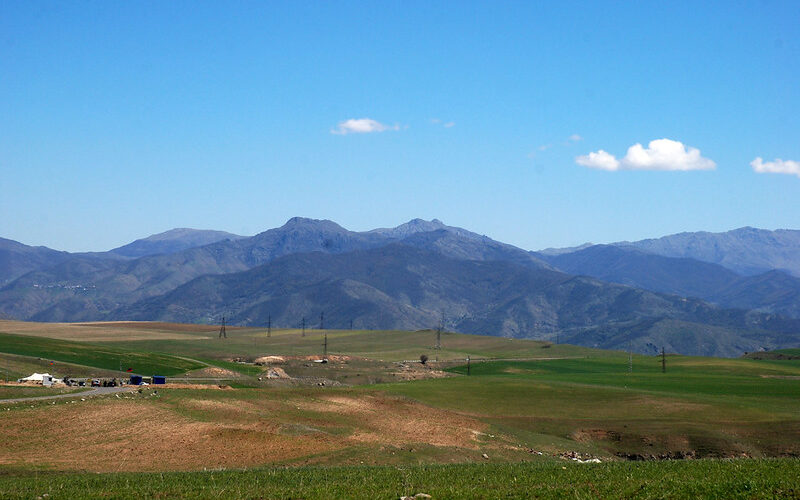Two and a half years after Armenia and Azerbaijan ended the 44-day war they fought over Nagorno-Karabakh, Yerevan seems to have completely relinquished the mountainous region that was under the Armenian forces’ control for almost three decades. A new reality on the ground could soon force the Karabakh Armenians to make a difficult choice – to leave their homes and move to Armenia, or to integrate into Azerbaijani society.
On April 23 Azerbaijan announced it had set up a checkpoint on the Lachin corridor, the only land link between Armenia and Nagorno-Karabakh. One week later, the energy-rich South Caucasus nation built a new border checkpoint in the region, which means that Armenia can no longer supply weapons to the self-proclaimed Republic of Artsakh (Artsakh being the Armenian name for Nagorno-Karabakh). In other words, if another round of hostilities in the mountainous region eventually breaks out, Azerbaijan will not have a hard time restoring its sovereignty over the territory that is still under Armenian control.
The Karabakh Armenians cannot even count on the Russian peacekeepers’ protection. As a result of the Russian-brokered 2020 ceasefire deal, some 2,000 Russian troops have been deployed to Nagorno-Karabakh. One of their major tasks was to secure the safety of the Lachin corridor. But given that they did not even attempt to prevent Azerbaijan from establishing a checkpoint on the road, it is improbable that they would intervene to protect the local Armenians in case of a potential Azerbaijani attempt to forcefully establish full control over the region.
At this point, it remains unclear if Baku has had the green light from the United States to launch such an operation. The US-hosted negotiations between Armenia and Azerbaijan on May 1, seeking to quell tension over Nagorno-Karabakh. Previously, on April 30, the US Secretary of State Antony Blinken spoke with Azerbaijan President Ilham Aliyev expressing concerns about the new checkpoint, which he said “undermines efforts to establish confidence in the peace process”. He also reiterated the American position that there should be open movement of people and commerce on the Lachin corridor.
Today I spoke with Azerbaijani President Aliyev to convey my support for continued efforts aimed at securing peace with Armenia and our willingness to facilitate. I reiterated the U.S. position that there should be open movement of people and commerce on the Lachin corridor.
— Secretary Antony Blinken (@SecBlinken) April 30, 2023
Baku, for its part, insists that it had set up a checkpoint on Azerbaijan’s territory. Indeed, Nagorno-Karabakh has been internationally recognized as part of Azerbaijan. More importantly, on April 18 the Armenian Prime Minister Nikol Pashinyan said that his country fully recognizes the territorial integrity of the neighboring state. Thus, formally speaking, what is happening on the Lachin corridor is an internal matter for Azerbaijan.
Yerevan, on the other hand, claims that the deployment of a checkpoint on the Lachin corridor contradicts the ceasefire agreements between Armenia and Azerbaijan. Armenian Foreign Minister Ararat Mirzoyan insists that his country “has no plans” to hold talks with Baku about unblocking the Lachin corridor, “since this issue was settled under the trilateral statement of November 9, 2020”. In reality, it is Azerbaijan, rather than Armenia, that is not willing to discuss the situation around the Lachin corridor. Mirzoyan’s statement only illustrates Yerevan’s impotence.
The former Soviet republic’s position is rather difficult. It lost the 2020 war, and Russia – Armenia’s nominal ally – demonstrated on several occasions that is not willing to protect not only the Karabakh Armenians, but Armenia itself either. Therefore, under the current geopolitical circumstances, there is nothing Yerevan can do to help the Armenian population in Nagorno-Karabakh. Their fate will likely depend on Azerbaijan’s goodwill, as well as on the United States’ interests in the region.
“Armenians living in Karabakh have to either take up Azerbaijani citizenship or seek another place of residence” said Azerbaijani President Aliyev on April 19.
Given that Washington is interested in a normalization of relations between the two archenemies – since a potential US-brokered peace agreement would undermine Russia’s influence in the South Caucasus – America is expected to pressure Baku to refrain from violence, or at least from a large-scale escalation of the conflict. Armenia, on the other hand, looks for ways to replace the Russian peacekeepers in the region with the UN, or some other international mission, hoping that such an outcome would guarantee security to the local Armenians. But chances for Yerevan to achieve such an ambitious goal are rather slim. Unless seriously pressured by the United States – which does not seem very probable at this point – Azerbaijan does not have any reasons to allow any foreign troops on its territory after 2025, which is when the Russian peacekeepers’ mandate expires.
Meanwhile, Baku will likely continue pushing Yerevan to complete its section of the Nakhchivan corridor (also known as theZangezur corridor) – a transportation route that would connect the mainland Azerbaijan with its exclave of Nakhchivan through Armenia’s southernmost province of Syunik. Baku expect the landlocked nation of around three million to build road and rail links along its border with Iran, with no passport or customs controls, which is something Armenia resolutely opposes. But since Azerbaijan – firmly backed by its ally Turkey, and indirectly supported by the European Union that aims to develop close energy cooperation with Baku – has a significant leverage over its neighbor, Yerevan may eventually be forced to build its part of the Nakhchivan corridor under Azerbaijani conditions.
Therefore, unless it manages to get a serious support from global or regional actors – the United States and Iran being Armenia’s best choices – in the foreseeable future the former Soviet republic can lose control not only over Nagorno-Karabakh, but also over parts of southern Armenia.
Image: Lachin Corridor by Jelger Groeneveld

